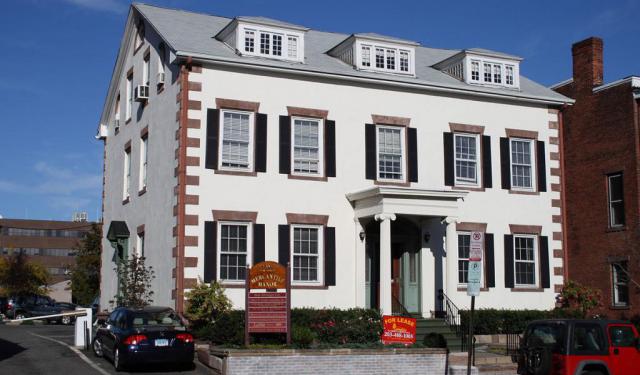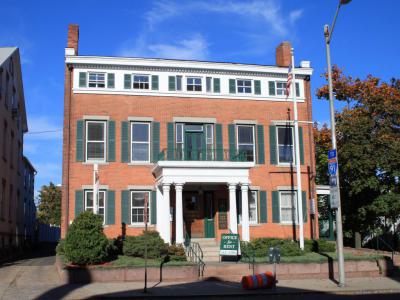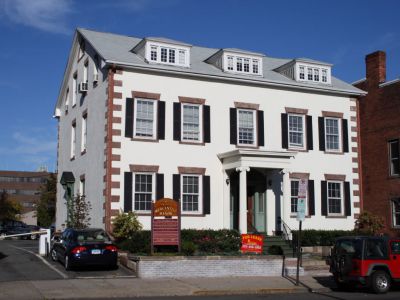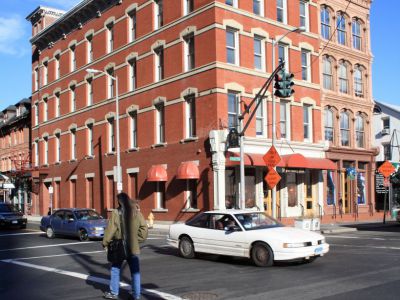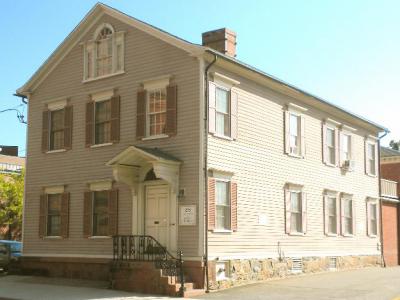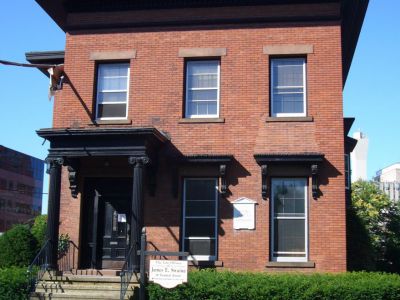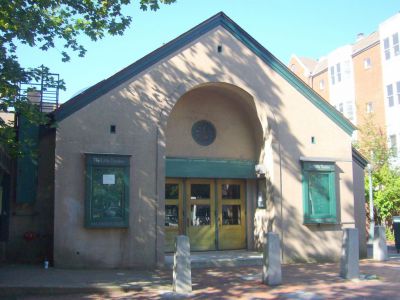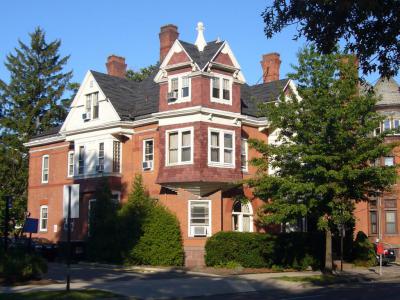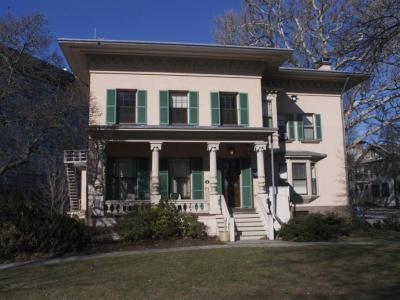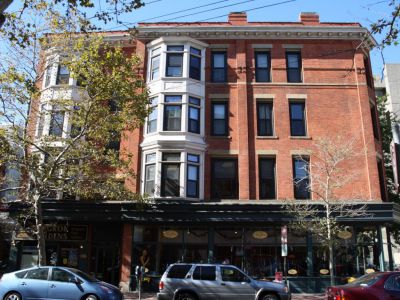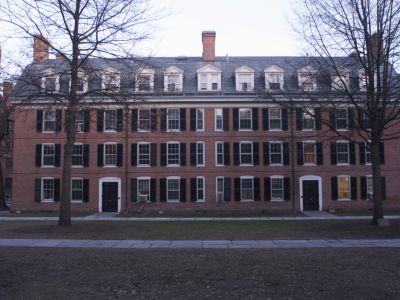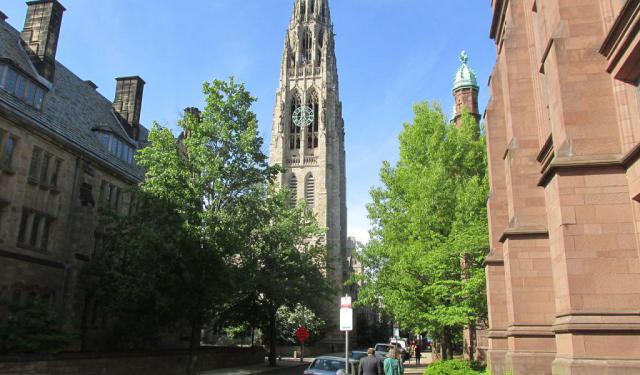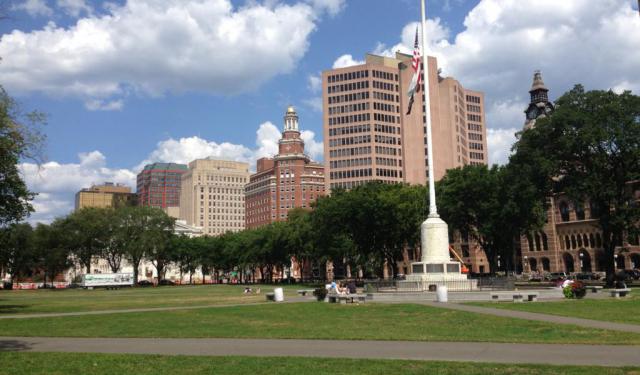New Haven's Historical Buildings Tour (Self Guided), New Haven
The first ever planned city in the United States, New Haven, Connecticut, is famous for a wealth of prominent homes that have stood the test of time.
Some of these buildings, like the Caroline Nicoll House, showcase the elegant symmetry and refined detailing befitting Federal style. Others, like the John Cook House, represent a prime example of the Greek Revival architecture, characterized by ionic columns and pediments.
In the heart of New Haven's downtown area, you'll find the Imperial Granum-Joseph Parker and Elisha Blackman Buildings, remarkable for their late 19th-century commercial appearance.
Meanwhile, the William Pinto House offers a glimpse into the Federal-style post-and-beam construction with a typical façade and steeply pitched roof.
The Lafayette B. Mendel and the James Dwight Dana Houses stand out as fine specimens of Italianate architecture, while the Lincoln Theatre represents the so-called Modern Movement devoid of ornate details and a rather modest entrance.
The Russell Henry Chittenden House is an elegant Queen Anne-style residence, characterized by its projecting gabled sections and asymmetrical design.
History enthusiasts will surely appreciate the iconic, colonial-era Connecticut Hall, one of the oldest buildings in New Haven, dating back to the 1750s.
As stewards of the city's history, these old buildings deserve celebration as architectural treasures. Consider exploring them now and learn the story of the remarkable structures that have shaped the character of New Haven as we know it.
Some of these buildings, like the Caroline Nicoll House, showcase the elegant symmetry and refined detailing befitting Federal style. Others, like the John Cook House, represent a prime example of the Greek Revival architecture, characterized by ionic columns and pediments.
In the heart of New Haven's downtown area, you'll find the Imperial Granum-Joseph Parker and Elisha Blackman Buildings, remarkable for their late 19th-century commercial appearance.
Meanwhile, the William Pinto House offers a glimpse into the Federal-style post-and-beam construction with a typical façade and steeply pitched roof.
The Lafayette B. Mendel and the James Dwight Dana Houses stand out as fine specimens of Italianate architecture, while the Lincoln Theatre represents the so-called Modern Movement devoid of ornate details and a rather modest entrance.
The Russell Henry Chittenden House is an elegant Queen Anne-style residence, characterized by its projecting gabled sections and asymmetrical design.
History enthusiasts will surely appreciate the iconic, colonial-era Connecticut Hall, one of the oldest buildings in New Haven, dating back to the 1750s.
As stewards of the city's history, these old buildings deserve celebration as architectural treasures. Consider exploring them now and learn the story of the remarkable structures that have shaped the character of New Haven as we know it.
How it works: Download the app "GPSmyCity: Walks in 1K+ Cities" from Apple App Store or Google Play Store to your mobile phone or tablet. The app turns your mobile device into a personal tour guide and its built-in GPS navigation functions guide you from one tour stop to next. The app works offline, so no data plan is needed when traveling abroad.
New Haven's Historical Buildings Tour Map
Guide Name: New Haven's Historical Buildings Tour
Guide Location: USA » New Haven (See other walking tours in New Haven)
Guide Type: Self-guided Walking Tour (Sightseeing)
# of Attractions: 10
Tour Duration: 2 Hour(s)
Travel Distance: 2.9 Km or 1.8 Miles
Author: AudreyB
Sight(s) Featured in This Guide:
Guide Location: USA » New Haven (See other walking tours in New Haven)
Guide Type: Self-guided Walking Tour (Sightseeing)
# of Attractions: 10
Tour Duration: 2 Hour(s)
Travel Distance: 2.9 Km or 1.8 Miles
Author: AudreyB
Sight(s) Featured in This Guide:
- Caroline Nicoll House
- John Cook House
- Imperial Granum-Joseph Parker Buildings
- William Pinto House
- Lafayette B. Mendel House
- Lincoln Theatre
- Russell Henry Chittenden House
- James Dwight Dana House
- Elisha Blackman Building
- Connecticut Hall
1) Caroline Nicoll House
Located on Elm Street in downtown New Haven, the Caroline Nicoll House stands as a rare and elegant reminder of early 19th-century urban architecture. Built in 1828, it exemplifies the transitional style between the Federal and Greek Revival movements, retaining many of its original architectural details despite centuries of change.
Constructed by prominent local statesman Abraham Bishop as a wedding gift for his daughter Caroline and her husband, businessman Charles Nicoll, the house remained in the Nicoll family until 1894. It was then purchased by a physician who modified the rear of the building-adding an ell to accommodate his medical office. By the 1930s, the structure had been fully adapted for professional office use, a function it still serves today.
The house itself is a 2½-story brick townhouse, five bays wide, with distinctive stepped gable ends and paired chimneys. Its main entrance features a portico supported by striking Egyptian-style columns. At the rear, a two-story ell and a later single-story extension reflect its adaptive evolution over time. Despite the building's commercial conversion, the interior still boasts original features such as fireplace surrounds and trim work.
Just a short walk from the New Haven Green, the Caroline Nicoll House is not only architecturally significant but also historically resilient. It has withstood the pressures of urban renewal and redevelopment, earning it a place on the National Register of Historic Places in 1983.
Constructed by prominent local statesman Abraham Bishop as a wedding gift for his daughter Caroline and her husband, businessman Charles Nicoll, the house remained in the Nicoll family until 1894. It was then purchased by a physician who modified the rear of the building-adding an ell to accommodate his medical office. By the 1930s, the structure had been fully adapted for professional office use, a function it still serves today.
The house itself is a 2½-story brick townhouse, five bays wide, with distinctive stepped gable ends and paired chimneys. Its main entrance features a portico supported by striking Egyptian-style columns. At the rear, a two-story ell and a later single-story extension reflect its adaptive evolution over time. Despite the building's commercial conversion, the interior still boasts original features such as fireplace surrounds and trim work.
Just a short walk from the New Haven Green, the Caroline Nicoll House is not only architecturally significant but also historically resilient. It has withstood the pressures of urban renewal and redevelopment, earning it a place on the National Register of Historic Places in 1983.
2) John Cook House
The John Cook House, located on Elm Street in downtown New Haven, is a historic landmark built around 1807. Just two blocks east of the New Haven Green, it stands as one of the city's oldest surviving stone buildings and has hosted a long line of notable residents with ties to local and state history.
Architecturally, the house is a refined example of early 19th-century design. It rises 2½ stories high, constructed from ashlar-cut red sandstone with distinctive corner quoins left exposed, while the rest of the exterior is stuccoed. A gabled roof, pierced by three low hip-roof dormers, tops the structure. The symmetrical facade features rectangular sash windows and a central entrance framed by stone sills and lintels, with elegant sidelight windows and a classical Ionic-columned portico.
John Cook, a tailor and merchant, purchased the land in 1805–06 and soon after built the house. At the time, New Haven had no stone buildings, according to an 1800 report by Timothy Dwight, making this one of the city's first of its kind. In 1814, Cook sold the property to Captain James Goodrich, a privateer during the War of 1812. Goodrich added the third-floor ballroom, likely built by noted local craftsman David Hoadley-later a key figure in regional rail development.
Subsequent owners include Charles Atwater, a businessman, legislator, and gubernatorial candidate, and Dr. Charles Lindsley, a pioneer in public health who established New Haven's Department of Health. From 1919 to 1967, the building served as the headquarters of the local Visiting Nurse Association.
Listed on the National Register of Historic Places in 1983, the John Cook House is now known as The Atwater and functions as professional office space. While the interior has seen some renovation, the building remains a vital architectural and historical presence in the heart of New Haven.
Architecturally, the house is a refined example of early 19th-century design. It rises 2½ stories high, constructed from ashlar-cut red sandstone with distinctive corner quoins left exposed, while the rest of the exterior is stuccoed. A gabled roof, pierced by three low hip-roof dormers, tops the structure. The symmetrical facade features rectangular sash windows and a central entrance framed by stone sills and lintels, with elegant sidelight windows and a classical Ionic-columned portico.
John Cook, a tailor and merchant, purchased the land in 1805–06 and soon after built the house. At the time, New Haven had no stone buildings, according to an 1800 report by Timothy Dwight, making this one of the city's first of its kind. In 1814, Cook sold the property to Captain James Goodrich, a privateer during the War of 1812. Goodrich added the third-floor ballroom, likely built by noted local craftsman David Hoadley-later a key figure in regional rail development.
Subsequent owners include Charles Atwater, a businessman, legislator, and gubernatorial candidate, and Dr. Charles Lindsley, a pioneer in public health who established New Haven's Department of Health. From 1919 to 1967, the building served as the headquarters of the local Visiting Nurse Association.
Listed on the National Register of Historic Places in 1983, the John Cook House is now known as The Atwater and functions as professional office space. While the interior has seen some renovation, the building remains a vital architectural and historical presence in the heart of New Haven.
3) Imperial Granum-Joseph Parker Buildings
The Imperial Granum-Joseph Parker Buildings, also historically known as the Del Monico Building, are a striking pair of conjoined 19th-century commercial buildings located at the corner of Elm and Orange Streets in downtown New Haven, Connecticut-just a block east of the iconic New Haven Green.
Built in 1875 (Parker) and 1877 (Imperial Granum), the two buildings showcase some of the city’s finest surviving examples of late 19th-century commercial architecture. Notably, the Imperial Granum Building retains New Haven’s only surviving cast-iron facade on a ground floor-a rare architectural detail in the city, where cast iron was never widely adopted. This feature, along with the richly ornamented masonry and stylized classical detailing, earned the buildings a spot on the National Register of Historic Places in 1986.
The Parker Building, constructed from red brick, anchors the street corner and originally served as a warehouse for a paper manufacturer. Its modern ground-floor facade is designed to echo the style of its narrower neighbor, the Imperial Granum. Above the ground level, its windows are rectangular with peaked stone lintels, while the Orange Street side includes blinded window bays and a secondary entrance.
Next door, the Imperial Granum Building-named after a patent medicine sold by its owner, Edward Heaton-features more elaborate upper-level window surrounds with segmented arches, engaged columns, and decorative cornices. For many years, an advertisement for Imperial Granum adorned its southeastern wall.
Architecturally, both buildings have been attributed to designers from Henry Austin’s office: David R. Brown for the Parker Building and Rufus G. Russell for the Imperial Granum. In 1945, the two structures came under single ownership and were internally joined on the upper floors via a shared staircase and party wall openings.
Today, these well-preserved buildings continue to make their mark in downtown New Haven, with the ground floor home to Del Monico’s hat shop, adding a dash of retail charm to their historic legacy.
Built in 1875 (Parker) and 1877 (Imperial Granum), the two buildings showcase some of the city’s finest surviving examples of late 19th-century commercial architecture. Notably, the Imperial Granum Building retains New Haven’s only surviving cast-iron facade on a ground floor-a rare architectural detail in the city, where cast iron was never widely adopted. This feature, along with the richly ornamented masonry and stylized classical detailing, earned the buildings a spot on the National Register of Historic Places in 1986.
The Parker Building, constructed from red brick, anchors the street corner and originally served as a warehouse for a paper manufacturer. Its modern ground-floor facade is designed to echo the style of its narrower neighbor, the Imperial Granum. Above the ground level, its windows are rectangular with peaked stone lintels, while the Orange Street side includes blinded window bays and a secondary entrance.
Next door, the Imperial Granum Building-named after a patent medicine sold by its owner, Edward Heaton-features more elaborate upper-level window surrounds with segmented arches, engaged columns, and decorative cornices. For many years, an advertisement for Imperial Granum adorned its southeastern wall.
Architecturally, both buildings have been attributed to designers from Henry Austin’s office: David R. Brown for the Parker Building and Rufus G. Russell for the Imperial Granum. In 1945, the two structures came under single ownership and were internally joined on the upper floors via a shared staircase and party wall openings.
Today, these well-preserved buildings continue to make their mark in downtown New Haven, with the ground floor home to Del Monico’s hat shop, adding a dash of retail charm to their historic legacy.
4) William Pinto House
Located on Orange Street, just east of the New Haven Green, the William Pinto House-also known as the William Pinto–Eli Whitney House-is a well-preserved example of early 19th-century Federal-style architecture. Built in 1810 for merchant John Cook, the house is notable for its unusual front-facing gable, a rare design choice for the Federal period, where gables were more typically oriented to the side.
Constructed with post-and-beam framing and clad in clapboard, the 2½-story wood-frame house features a three-bay-wide façade with a side-placed entrance framed by pilasters, a half-round transom, and a distinctive gabled hood with carved brackets. Above, a Palladian window accents the gable, while sash windows with corniced lintels balance the symmetrical design. Inside, original details like fireplace surrounds and trim work have been retained.
In 1812, the home was purchased by William Pinto, a Revolutionary War militia officer and successful West Indies merchant from one of New Haven’s earliest Jewish families. Pinto later leased the home to Eli Whitney, the famed inventor of the cotton gin, who lived there from 1819 until his death in 1825.
Once part of an upper-class residential neighborhood, Orange Street has evolved into a bustling commercial area. The William Pinto House, now used for professional offices, was recognized for its historical and architectural significance with a listing on the National Register of Historic Places in 1985.
Constructed with post-and-beam framing and clad in clapboard, the 2½-story wood-frame house features a three-bay-wide façade with a side-placed entrance framed by pilasters, a half-round transom, and a distinctive gabled hood with carved brackets. Above, a Palladian window accents the gable, while sash windows with corniced lintels balance the symmetrical design. Inside, original details like fireplace surrounds and trim work have been retained.
In 1812, the home was purchased by William Pinto, a Revolutionary War militia officer and successful West Indies merchant from one of New Haven’s earliest Jewish families. Pinto later leased the home to Eli Whitney, the famed inventor of the cotton gin, who lived there from 1819 until his death in 1825.
Once part of an upper-class residential neighborhood, Orange Street has evolved into a bustling commercial area. The William Pinto House, now used for professional offices, was recognized for its historical and architectural significance with a listing on the National Register of Historic Places in 1985.
5) Lafayette B. Mendel House
Located on Trumbull Street in New Haven, the Lafayette B. Mendel House is a historic Italianate-style residence best known for its association with pioneering nutrition scientist Lafayette Benedict Mendel (1872–1935). Designed by noted local architect Henry Austin, the house was constructed around 1858 and is one of the earlier structures in a neighborhood that saw most of its development in the 1880s.
Architecturally, the two-story brick house features a hip roof topped with a square cupola, broad eaves, and a front entrance sheltered by a portico supported by Doric columns. While not particularly elaborate in design, the house retains much of its original woodwork and interior detailing, despite later adaptations for use as professional office space-it is currently occupied by a law firm.
The home’s historical importance lies in its former resident, Lafayette B. Mendel, who lived here from 1900 to 1924. Mendel, a Yale University physiology professor, and a biochemist trained under Russell Henry Chittenden, made groundbreaking contributions to the understanding of human nutrition. His work, often conducted in collaboration with Thomas B. Osborne, led to the identification of vitamins A and B, a clearer understanding of amino acids, and the realization that different proteins have varying nutritional values.
In recognition of its scientific and historical significance, the Lafayette B. Mendel House was designated a National Historic Landmark in 1976.
Architecturally, the two-story brick house features a hip roof topped with a square cupola, broad eaves, and a front entrance sheltered by a portico supported by Doric columns. While not particularly elaborate in design, the house retains much of its original woodwork and interior detailing, despite later adaptations for use as professional office space-it is currently occupied by a law firm.
The home’s historical importance lies in its former resident, Lafayette B. Mendel, who lived here from 1900 to 1924. Mendel, a Yale University physiology professor, and a biochemist trained under Russell Henry Chittenden, made groundbreaking contributions to the understanding of human nutrition. His work, often conducted in collaboration with Thomas B. Osborne, led to the identification of vitamins A and B, a clearer understanding of amino acids, and the realization that different proteins have varying nutritional values.
In recognition of its scientific and historical significance, the Lafayette B. Mendel House was designated a National Historic Landmark in 1976.
6) Lincoln Theatre
Tucked away on Lincoln Street in a quiet residential corner of New Haven, the Lincoln Theatre-also known as the Little Theatre on Lincoln Street-is a rare and resilient relic of the early 20th-century American theater movement. Built in 1924, it holds the distinction of being the only surviving venue in Connecticut associated with the Little Theatre Movement (1911–1933), a grassroots push for intimate, non-commercial, and often experimental theater.
Designed as a dedicated performance space, the theatre features a gable-roofed auditorium and entryway, with backstage and dressing room facilities housed in the rear. In the 2010s, a sleek glass-and-stone addition was built on the left side of the original structure, blending modern design with historical charm. Located just three blocks from the New Haven Green, the building stands as both a neighborhood landmark and a cultural time capsule.
The Lincoln Theatre's early years were shaped by Yale professor Jack Crawford and his circle of creatives. After 1935, it came under the wing of the Federal Theater Project, part of the New Deal's Works Progress Administration, until the project ended in 1939. The venue then pivoted to commercial theater and, by 1945, was reborn as a film house specializing in foreign and art films. Under the ownership of Robert Spodick-who also ran the York Square Cinemas-the Lincoln Theatre became a local favorite until its closure in 1982.
Two years later, in 1986, the theater found new life when it was acquired by ACES Educational Center for the Arts, a public arts magnet school. Initially used for private and school-related events, the building underwent a significant restoration in 2012, revitalizing its Art Deco interiors and theatrical functionality. Rebranded as the ACES Little Theatre, it continues to serve the local community as a performance space and educational hub.
Listed on the National Register of Historic Places since 1984, the Lincoln Theatre is a testament to New Haven’s layered cultural history-a space where performance, preservation, and education intersect.
Designed as a dedicated performance space, the theatre features a gable-roofed auditorium and entryway, with backstage and dressing room facilities housed in the rear. In the 2010s, a sleek glass-and-stone addition was built on the left side of the original structure, blending modern design with historical charm. Located just three blocks from the New Haven Green, the building stands as both a neighborhood landmark and a cultural time capsule.
The Lincoln Theatre's early years were shaped by Yale professor Jack Crawford and his circle of creatives. After 1935, it came under the wing of the Federal Theater Project, part of the New Deal's Works Progress Administration, until the project ended in 1939. The venue then pivoted to commercial theater and, by 1945, was reborn as a film house specializing in foreign and art films. Under the ownership of Robert Spodick-who also ran the York Square Cinemas-the Lincoln Theatre became a local favorite until its closure in 1982.
Two years later, in 1986, the theater found new life when it was acquired by ACES Educational Center for the Arts, a public arts magnet school. Initially used for private and school-related events, the building underwent a significant restoration in 2012, revitalizing its Art Deco interiors and theatrical functionality. Rebranded as the ACES Little Theatre, it continues to serve the local community as a performance space and educational hub.
Listed on the National Register of Historic Places since 1984, the Lincoln Theatre is a testament to New Haven’s layered cultural history-a space where performance, preservation, and education intersect.
7) Russell Henry Chittenden House
The Russell Henry Chittenden House in New Haven stands as a tribute to one of Yale University’s most influential scientists and educators. Built in the 1880s and purchased by Chittenden in 1887-likely from the original builder-the home served as his residence until he died in 1943. Chittenden, often hailed as the “father of American biochemistry,” left a profound mark on science through his pioneering work in digestion and nutrition, as well as his leadership at Yale, where he developed one of the country's premier biochemistry departments.
Architecturally, the house reflects the Queen Anne style popular in the late 19th century. This three-story, irregularly shaped brick structure features gabled projections, tall chimneys with decorative corbelling, and a distinctive square turret clad in shingles. While the interior has been reconfigured into multiple units, many of the original decorative details have been preserved, maintaining its historical character.
Recognizing both its architectural significance and its association with Chittenden, the house was designated a National Historic Landmark in 1975. It also contributes to the character of the Hillhouse Avenue Historic District, a notable area in New Haven renowned for its 19th-century residences and ties to Yale University.
Born in New Haven in 1856, Chittenden studied chemistry at Yale before traveling to Germany in 1878, where his fascination with digestive chemistry took root. Appointed a Yale professor in 1882, he dedicated his career to unraveling the role of enzymes in protein breakdown and laying foundational work in nutritional science-advances that would shape the future of biochemistry in the United States.
Architecturally, the house reflects the Queen Anne style popular in the late 19th century. This three-story, irregularly shaped brick structure features gabled projections, tall chimneys with decorative corbelling, and a distinctive square turret clad in shingles. While the interior has been reconfigured into multiple units, many of the original decorative details have been preserved, maintaining its historical character.
Recognizing both its architectural significance and its association with Chittenden, the house was designated a National Historic Landmark in 1975. It also contributes to the character of the Hillhouse Avenue Historic District, a notable area in New Haven renowned for its 19th-century residences and ties to Yale University.
Born in New Haven in 1856, Chittenden studied chemistry at Yale before traveling to Germany in 1878, where his fascination with digestive chemistry took root. Appointed a Yale professor in 1882, he dedicated his career to unraveling the role of enzymes in protein breakdown and laying foundational work in nutritional science-advances that would shape the future of biochemistry in the United States.
8) James Dwight Dana House
The James Dwight Dana House, located on Hillhouse Avenue in New Haven, is a significant 19th-century residence both architecturally and historically. Built in 1848–49 for geologist James Dwight Dana and his wife Henrietta Silliman, the house was a wedding gift from her father, Benjamin Silliman, one of Yale’s pioneering science professors. Designed by prominent New Haven architect Henry Austin, the home reflects the Italianate style prevalent in that era.
The structure features three painted brick sections, each roughly rectangular and 2½ stories high, with a low-pitched hip roof and wide eaves supported by a wooden soffit and decorative corbelled brickwork arches. A square cupola crowns the main block, while a three-bay front façade and a single-story porch supported by turned posts add to its elegant yet understated character. Though not unique in design-other similar houses exist-the Dana House has remained largely intact inside, preserving much of its original craftsmanship. Additions in 1896 and 1905 expanded the home to the north and east, maintaining architectural harmony with the original.
The house’s historic value lies primarily in its association with James Dwight Dana (1813–1895), one of the most influential American geologists of the 19th century. A Yale professor and key figure in the United States Exploring Expedition (1838–42), Dana helped redefine the study of geology. His seminal work, the Manual of Geology (1862), was the first to present geology as more than the classification of rocks-it framed the discipline as an exploration of the processes shaping Earth’s landforms, such as mountain-building and valley formation.
Recognizing its cultural and scientific importance, the house was declared a National Historic Landmark in 1965, listed on the National Register of Historic Places in 1966, and included as a contributing property in the Hillhouse Avenue Historic District in 1985. In 1962, Yale University acquired the building, and after a 1996 renovation, it became home to the university’s Department of Statistics & Data Science, continuing its legacy of scientific inquiry.
The structure features three painted brick sections, each roughly rectangular and 2½ stories high, with a low-pitched hip roof and wide eaves supported by a wooden soffit and decorative corbelled brickwork arches. A square cupola crowns the main block, while a three-bay front façade and a single-story porch supported by turned posts add to its elegant yet understated character. Though not unique in design-other similar houses exist-the Dana House has remained largely intact inside, preserving much of its original craftsmanship. Additions in 1896 and 1905 expanded the home to the north and east, maintaining architectural harmony with the original.
The house’s historic value lies primarily in its association with James Dwight Dana (1813–1895), one of the most influential American geologists of the 19th century. A Yale professor and key figure in the United States Exploring Expedition (1838–42), Dana helped redefine the study of geology. His seminal work, the Manual of Geology (1862), was the first to present geology as more than the classification of rocks-it framed the discipline as an exploration of the processes shaping Earth’s landforms, such as mountain-building and valley formation.
Recognizing its cultural and scientific importance, the house was declared a National Historic Landmark in 1965, listed on the National Register of Historic Places in 1966, and included as a contributing property in the Hillhouse Avenue Historic District in 1985. In 1962, Yale University acquired the building, and after a 1996 renovation, it became home to the university’s Department of Statistics & Data Science, continuing its legacy of scientific inquiry.
9) Elisha Blackman Building
The Elisha Blackman Building, also known as the York-Chapel Building, is a notable historic structure located on York Street, at the southwest corner of York and Chapel Streets in Downtown New Haven. Built in 1883, this four-story mixed-use commercial and residential block is a distinguished example of 19th-century commercial architecture, notable for its high-quality craftsmanship and survival amid a cityscape that has lost many of its peers. It was officially listed on the National Register of Historic Places in 1978.
The building is constructed of red brick with stone trim and features a trapezoidal footprint, a result of the uniquely shaped lot it occupies. Its ground floor includes four storefronts-one facing York Street and three on Chapel Street. The Chapel Street façade is defined by stone columns that separate the shops, while brick pilasters divide the York Street frontage. The upper floors feature polygonal bay and rectangular windows, adding height and visual appeal, while a metal-clad cornice crowns the building’s architectural style.
Originally built on a site that once hosted three houses, the building was a speculative commercial investment by Elisha Blackman, a local carriage maker. The identity of its architect remains unknown, though the structure’s design and material quality reflect a careful attention to detail. In the 1920s, the second floor was converted from residential apartments to professional offices, and the façade was extended to the sidewalk, supported by lally columns and steel beams-a significant early 20th-century modification.
The Elisha Blackman Building helped transform Upper Chapel Street from a residential to a commercial area, marking one of the first such developments west of High Street. Despite a 1977 fire and period of vacancy, it remains a rare and significant piece of New Haven’s architectural history.
The building is constructed of red brick with stone trim and features a trapezoidal footprint, a result of the uniquely shaped lot it occupies. Its ground floor includes four storefronts-one facing York Street and three on Chapel Street. The Chapel Street façade is defined by stone columns that separate the shops, while brick pilasters divide the York Street frontage. The upper floors feature polygonal bay and rectangular windows, adding height and visual appeal, while a metal-clad cornice crowns the building’s architectural style.
Originally built on a site that once hosted three houses, the building was a speculative commercial investment by Elisha Blackman, a local carriage maker. The identity of its architect remains unknown, though the structure’s design and material quality reflect a careful attention to detail. In the 1920s, the second floor was converted from residential apartments to professional offices, and the façade was extended to the sidewalk, supported by lally columns and steel beams-a significant early 20th-century modification.
The Elisha Blackman Building helped transform Upper Chapel Street from a residential to a commercial area, marking one of the first such developments west of High Street. Despite a 1977 fire and period of vacancy, it remains a rare and significant piece of New Haven’s architectural history.
10) Connecticut Hall
Connecticut Hall, formerly known as South Middle College, is a Georgian-style landmark on Yale University’s Old Campus in New Haven. Completed in 1752, it is Yale’s oldest surviving building and the second-oldest structure built for the college after it relocated to New Haven in 1718. Originally constructed as a student dormitory, it served that role for 200 years before being converted into academic offices. Today, it houses Yale’s Department of Philosophy, while its third floor serves as a meeting space for the Yale Faculty of Arts & Sciences.
Connecticut Hall holds a special place in American academic architecture-it’s the third-oldest surviving college building from the colonial era in the United States and the last remaining example of Yale’s original Old Brick Row campus plan. The building was constructed by Francis Letort and Thomas Bills, with labor that included enslaved African workers, one of whom was owned by Yale’s then-president Thomas Clap. Funding came from a mix of creative sources, including a Connecticut Assembly grant, a lottery, and the sale of a captured French ship.
Architecturally modeled after Harvard’s Massachusetts Hall, Connecticut Hall set the tone for Yale’s future building designs and even influenced campus architecture elsewhere, including the University of Georgia’s Old College and the first dormitories at Miami University in Ohio-an institution once nicknamed the "Yale of the Early West."
Over the centuries, the building has seen several significant renovations: a fourth floor was added in 1797, but this was later removed in 1905 during a restoration that aimed to recapture its colonial appearance, including the original gambrel roof. Between 1952 and 1954, its interior was entirely rebuilt to better suit academic needs.
Saved from demolition during a 19th-century push to modernize the campus, Connecticut Hall remains a vital historical and academic presence at Yale. In recognition of its cultural and architectural importance, it was designated a National Historic Landmark in 1965.
Connecticut Hall holds a special place in American academic architecture-it’s the third-oldest surviving college building from the colonial era in the United States and the last remaining example of Yale’s original Old Brick Row campus plan. The building was constructed by Francis Letort and Thomas Bills, with labor that included enslaved African workers, one of whom was owned by Yale’s then-president Thomas Clap. Funding came from a mix of creative sources, including a Connecticut Assembly grant, a lottery, and the sale of a captured French ship.
Architecturally modeled after Harvard’s Massachusetts Hall, Connecticut Hall set the tone for Yale’s future building designs and even influenced campus architecture elsewhere, including the University of Georgia’s Old College and the first dormitories at Miami University in Ohio-an institution once nicknamed the "Yale of the Early West."
Over the centuries, the building has seen several significant renovations: a fourth floor was added in 1797, but this was later removed in 1905 during a restoration that aimed to recapture its colonial appearance, including the original gambrel roof. Between 1952 and 1954, its interior was entirely rebuilt to better suit academic needs.
Saved from demolition during a 19th-century push to modernize the campus, Connecticut Hall remains a vital historical and academic presence at Yale. In recognition of its cultural and architectural importance, it was designated a National Historic Landmark in 1965.
Walking Tours in New Haven, Connecticut
Create Your Own Walk in New Haven
Creating your own self-guided walk in New Haven is easy and fun. Choose the city attractions that you want to see and a walk route map will be created just for you. You can even set your hotel as the start point of the walk.
Amistad Freedom Trail
The Cuban schooner La Amistad made history in July 1839 when a group of African captives on board unshackled themselves during the voyage, took control of the ship, and eventually landed on the US shore. The slaves responsible for the revolt were interned in New Haven, Connecticut to be tried for mutiny and murder. The case known as The United States vs The Amistad (1841) gained international... view more
Tour Duration: 1 Hour(s)
Travel Distance: 1.8 Km or 1.1 Miles
Tour Duration: 1 Hour(s)
Travel Distance: 1.8 Km or 1.1 Miles
Yale University Walking Tour
Perhaps the main attraction that puts the picturesque town of New Haven, Connecticut, on the international tourist map is Yale University. Founded in 1701, this esteemed educational institution ranks among the oldest and most prestigious in the United States.
In addition to its academic excellence, and because of its age, Yale boasts a great deal of architectural beauty. A diverse range of... view more
Tour Duration: 1 Hour(s)
Travel Distance: 1.4 Km or 0.9 Miles
In addition to its academic excellence, and because of its age, Yale boasts a great deal of architectural beauty. A diverse range of... view more
Tour Duration: 1 Hour(s)
Travel Distance: 1.4 Km or 0.9 Miles
New Haven Introduction Walking Tour
New Haven, Connecticut is widely known as the home to Yale University. However, the city isn't just a hip, university town. It is also full of history and sites that can't be found anywhere else.
The first planned city in the United States, New Haven boasts the easily maneuvered grid layout which makes it easy to navigate the city on foot. Situated at the center of this grid, New... view more
Tour Duration: 2 Hour(s)
Travel Distance: 2.1 Km or 1.3 Miles
The first planned city in the United States, New Haven boasts the easily maneuvered grid layout which makes it easy to navigate the city on foot. Situated at the center of this grid, New... view more
Tour Duration: 2 Hour(s)
Travel Distance: 2.1 Km or 1.3 Miles
The Most Popular Cities
/ view all
